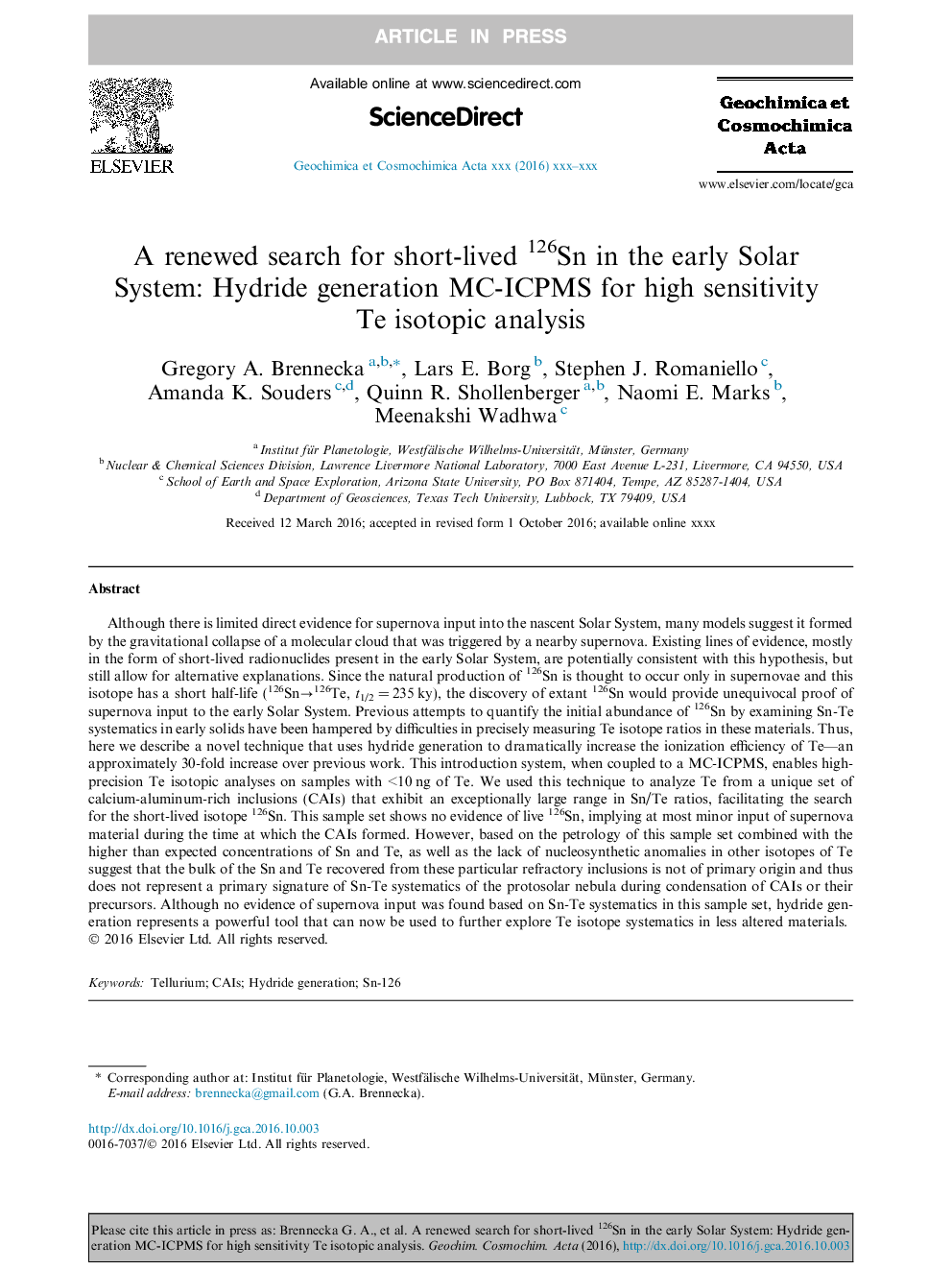| کد مقاله | کد نشریه | سال انتشار | مقاله انگلیسی | نسخه تمام متن |
|---|---|---|---|---|
| 5783475 | 1637956 | 2017 | 14 صفحه PDF | دانلود رایگان |
عنوان انگلیسی مقاله ISI
A renewed search for short-lived 126Sn in the early Solar System: Hydride generation MC-ICPMS for high sensitivity Te isotopic analysis
دانلود مقاله + سفارش ترجمه
دانلود مقاله ISI انگلیسی
رایگان برای ایرانیان
موضوعات مرتبط
مهندسی و علوم پایه
علوم زمین و سیارات
ژئوشیمی و پترولوژی
پیش نمایش صفحه اول مقاله

چکیده انگلیسی
Although there is limited direct evidence for supernova input into the nascent Solar System, many models suggest it formed by the gravitational collapse of a molecular cloud that was triggered by a nearby supernova. Existing lines of evidence, mostly in the form of short-lived radionuclides present in the early Solar System, are potentially consistent with this hypothesis, but still allow for alternative explanations. Since the natural production of 126Sn is thought to occur only in supernovae and this isotope has a short half-life (126Snâ126Te, t1/2Â =Â 235Â ky), the discovery of extant 126Sn would provide unequivocal proof of supernova input to the early Solar System. Previous attempts to quantify the initial abundance of 126Sn by examining Sn-Te systematics in early solids have been hampered by difficulties in precisely measuring Te isotope ratios in these materials. Thus, here we describe a novel technique that uses hydride generation to dramatically increase the ionization efficiency of Te-an approximately 30-fold increase over previous work. This introduction system, when coupled to a MC-ICPMS, enables high-precision Te isotopic analyses on samples with <10Â ng of Te. We used this technique to analyze Te from a unique set of calcium-aluminum-rich inclusions (CAIs) that exhibit an exceptionally large range in Sn/Te ratios, facilitating the search for the short-lived isotope 126Sn. This sample set shows no evidence of live 126Sn, implying at most minor input of supernova material during the time at which the CAIs formed. However, based on the petrology of this sample set combined with the higher than expected concentrations of Sn and Te, as well as the lack of nucleosynthetic anomalies in other isotopes of Te suggest that the bulk of the Sn and Te recovered from these particular refractory inclusions is not of primary origin and thus does not represent a primary signature of Sn-Te systematics of the protosolar nebula during condensation of CAIs or their precursors. Although no evidence of supernova input was found based on Sn-Te systematics in this sample set, hydride generation represents a powerful tool that can now be used to further explore Te isotope systematics in less altered materials.
ناشر
Database: Elsevier - ScienceDirect (ساینس دایرکت)
Journal: Geochimica et Cosmochimica Acta - Volume 201, 15 March 2017, Pages 331-344
Journal: Geochimica et Cosmochimica Acta - Volume 201, 15 March 2017, Pages 331-344
نویسندگان
Gregory A. Brennecka, Lars E. Borg, Stephen J. Romaniello, Amanda K. Souders, Quinn R. Shollenberger, Naomi E. Marks, Meenakshi Wadhwa,